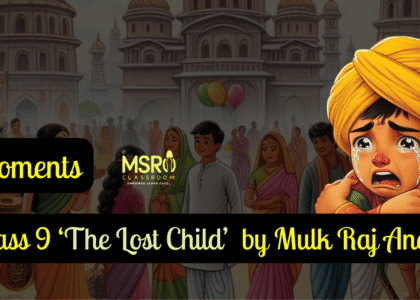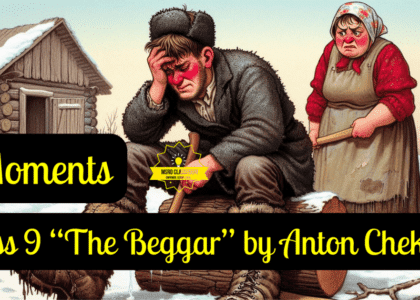Chapter 5, Oscar Wilde’s ‘The Happy Prince’ Summary, Theme, Character Sketches, Vocabulary, Questions Answers, Important Excerpts.
Chapter 5- The Happy Prince by Oscar Wilde:
Table of Contents
- More: Class 9 ‘Beehive‘- Prose
Summary ‘The Happy Prince’:
In Oscar Wilde’s The Happy Prince (adapted for CBSE ‘Moments’), a statue of a prince decked with gold and jewels overlooks a city. The prince was once happy but now sees the city’s suffering. On its way to Egypt, a swallow rests on the statue and becomes the prince’s messenger. The prince asks the swallow to take his jewels and gold to help the poor and suffering in the city.
As the swallow delivers the prince’s riches, it grows cold and dies at the statue’s feet, breaking the prince’s lead heart. Despite their sacrifices, the city officials dismiss the swallow and the statue, but God treasures them for their compassion.
Theme of ‘The Happy Prince’:
Timeless Tale of Selfless Love and Sacrifice:
The theme of The Happy Prince is selfless love and sacrifice. The Happy Prince and the Swallow give up everything to help the poor and suffering people in the city. Once ignorant of pain, the prince becomes compassionate, giving away his jewels and gold to ease others’ suffering.
The swallow, initially focused on its journey, learns to care for others by helping the prince. Their acts of kindness highlight the importance of empathy and generosity. The story also contrasts true beauty with superficial appearances, showing that real value lies in compassion and self-sacrifice rather than wealth and outward beauty.
Character Sketch of ‘The Happy Prince’:
1. Character Sketch: The Happy Prince
1. Appearance:
- Statue: Gilded all over with thin leaves of fine gold.
- Eyes: Two bright sapphires.
- Sword Hilt: A large red ruby.
2. Initial Traits:
- Royalty: Once, a prince who lived in luxury was called “the Happy Prince.”
- Unaware: Lived a life shielded from sorrow and hardship.
3. Transformation:
- Awareness: After death, as a statue, he sees the suffering and misery in the city below.
- Emotion: Though made of lead, his heart is filled with deep empathy and sorrow.
4. Actions:
- Selflessness: Sends precious jewels (ruby and sapphires) to help the poor and needy.
- Sacrifice: Gives away his gold leaves, becoming dull and grey, to aid those suffering.
5. Characteristics:
- Compassionate: Feels deep sympathy for the city’s suffering and takes action to alleviate it.
- Generous: Willing to sacrifice his beauty and wealth for the well-being of others.
- Heroic: After his loss and eventual blindness, he remains dedicated to helping the less fortunate.
6. Legacy:
Heaven’s Reward: God considers his heart and the swallow to be the most precious things in the city, showing that true value lies in selfless love and sacrifice.
2. Character Sketch: The Swallow
1. Appearance:
Feathers: Bright and beautiful.
Flight: Graceful and swift.
2. Initial Role:
- Traveller: Stayed behind while friends went to Egypt.
- Resting Place: Chooses to rest on the Happy Prince’s statue.
3. Key Traits:
- Curious: Wonders about the strange tears from the statue.
- Compassionate: Feels pity for the Happy Prince’s sadness.
- Generous: Willing to help despite his own plans.
4. Actions:
- Ruby Delivery: Takes a ruby to a poor seamstress/sewist to help her ill child.
- Sapphire Delivery: Delivers a sapphire to a struggling playwright to help him finish his work.
- Gold Removal: Assists the Happy Prince by taking off his gold leaves to give to the poor.
6. Personal Sacrifice:
- Stays Longer: Chooses to stay with the Happy Prince instead of flying to Egypt.
- Dies from Cold: Remains with the prince until he succumbs to the winter cold.
7. Legacy:
- Symbol of Selflessness: Represents true friendship and sacrifice.
- Final Rest: Lies beside the prince, honoured for his acts of kindness.
Questions Answers ‘The Happy Prince’:
Q1: Why do the courtiers call the prince ‘the Happy Prince’? Is he really happy? What does he see all around him?
A1: The courtiers call the prince “the Happy Prince” because when he was alive, he lived in a beautiful palace and was always happy. He never knew what sadness was. However, he is not happy now. As a statue, he stands high above the city, seeing all the suffering and sadness around him.
He sees poor people, hungry children, and those in need. This makes him very sad, and he cries because he cannot help them alone. The story shows true happiness comes from caring for others, not just living a comfortable life.
Q2: Why does the Happy Prince send a ruby for the seamstress? What does the swallow do in the seamstress’ house?
A2: The Happy Prince sends a ruby to the seamstress because she is penniless and her son is sick. She has no money to buy food or medicine for him, so the prince wants to help them. The ruby will give her some money to take care of her child.
The swallow, acting as the prince’s messenger, takes the ruby to the seamstress’s house. When the swallow arrives, he gently places the ruby on the table beside her. He then flies around the boy’s bed and fans him with his wings to make him feel cooler. The boy feels better and falls into a peaceful sleep.
Q3: For whom does the prince send the sapphires, and why?
A3: The prince sends the sapphires to help two people.
First, he sends one sapphire to a young playwright. The playwright is poor, cold, and hungry, making writing hard. The prince wants him to sell the sapphire to buy food and firewood so he can finish his play.
Next, the prince sends the second sapphire to a little matchgirl. She has dropped her matches in the gutter and can’t sell them. Her father will be angry if she doesn’t bring home any money. The prince gives her the sapphire so she can buy food and avoid getting in trouble. The prince gives up his eyes because he cares deeply for others.
Q4: What does the swallow see when it flies over the city?
A4: When the swallow flies over the city, it sees a lot of sadness and suffering. It notices rich people living in beautiful houses, enjoying themselves, while many poor people struggle. The swallow sees beggars sitting at the gates and hungry children with pale faces looking out at the dark streets.
It also sees two little boys huddled under a bridge, trying to stay warm because they have no home. The swallow realises there is a lot of misery in the city, with many people needing help. This sight makes the swallow understand why the Happy Prince wants to help so much.
Q5: Why did the swallow not leave the prince and go to Egypt?
A5: The swallow did not leave the prince to go to Egypt because it grew to care for him. At first, the swallow planned to leave, but after helping the prince give his jewels to the poor, it saw how kind and caring the prince was. The swallow started feeling warm and happy because of its good deeds.
Even though the weather got colder, and the swallow knew it should fly to Egypt to stay warm, it stayed because it wanted to help the prince. The swallow couldn’t leave the prince alone, especially after he became blind. The bond of friendship and love made the swallow stay by the prince’s side.
Q6: What are the precious things mentioned in the story? Why are they precious?
A6: The precious things mentioned in the story are the Happy Prince’s lead heart and the dead swallow. They are precious because they represent genuine kindness and love.
The prince gave away all his gold and jewels to help the poor and suffering people in the city. His lead heart was more valuable than gold because it showed his selflessness and compassion.
The swallow is also precious because it gave up its journey to warm Egypt to stay with the prince and help him carry out his good deeds. Even though the swallow was small, its actions were full of love and bravery. God chose these two as the most precious because of their pure and caring nature.
Talk About It:
The little swallow says, “It is curious, but I feel quite warm now, although it is so cold.” Have you ever had such a feeling? Share your experience with your friends.
| Yes, I have experienced such a feeling. One day, I found a small stray cat in the street. It was cold and raining, and the cat looked hungry and scared. I felt sorry for it, so I took it to my house. I dried it with a towel and gave it some food. The cat started to purr, looked happier and started following me everywhere. I felt a strange warmth inside my heart even though it was freezing outside. Helping the little cat made me feel good. My family was happy to see the cat safe, and we decided to keep it until we found its owner. That day, I learned that being kind to others can make you feel warm and happy inside. |
Extra Questions ‘The Happy Prince’ by Oscar Wilde:
Short Answer Type Questions:
Q1: Why does the Happy Prince cry when the swallow first meets him?
A1: The Happy Prince cries because he sees the suffering and misery in his city. He lived in a palace when he was alive and never knew sadness. Now, as a statue, he can see the poverty and hardship around him, making him very sad.
Q2: How does the swallow help the Happy Prince deliver his treasures?
A2: The swallow takes the jewels and gold from the Happy Prince’s statue and delivers them to needy people. He carries a ruby to a poor woman, a sapphire to a playwright, and gold leaves to help many poor children, spreading the prince’s kindness.
Q3: Why does the swallow stay with the Happy Prince instead of going to Egypt?
A3: The swallow stays with the Happy Prince because he feels sorry for the prince and wants to help him. Each time the prince asks him to help someone in need, the swallow agrees because he sees the goodness in the prince and wants to make others happy.
Q4: What happens to the Happy Prince’s statue at the end of the story?
A4: At the end of the story, the city officials see the statue as no longer beautiful because it has no jewels or gold. They take it down and melt it in a furnace. However, the prince’s lead heart doesn’t melt, so they throw it away with the dead swallow.
Q5: Why do the city officials think the Happy Prince’s statue is no longer useful?
A5: The city officials think the Happy Prince’s statue is useless because it has lost its beauty. The gold and jewels are gone, so they see it dull and ugly. They value the statue only for its appearance, not understanding its true worth or the kindness it showed.
Q6: How does the story show the theme of compassion?
A6: The story shows compassion through the Happy Prince and the swallow. The prince gives his gold and jewels to help the poor and suffering people in the city. The swallow stays with the prince, giving up his journey to Egypt to help others, showing kindness and self-sacrifice.
Q7: Why does God choose the swallow and the lead heart as the most precious things in the city?
A7: God chooses the swallow and the lead heart because they represent true love and kindness. The swallow sacrificed his life to help others, and the lead heart shows the prince’s generosity. They are precious because they cared for the poor and brought happiness, showing the true value of compassion.
Q8: What do you think the lead heart and the dead swallow symbolize in the story?
A8: The lead heart and the dead swallow symbolise genuine compassion and self-sacrifice. They show true value comes from helping others and showing love rather than wealth or appearance. The Happy Prince and the swallow’s actions teach that kindness and giving are the most important qualities.
Q9: How does the swallow feel after performing the good deeds requested by the Happy Prince?
A9: After helping the Happy Prince, the swallow feels warm and happy, even though it is cold outside. It finds joy in doing good deeds and feels satisfied knowing it made a difference in others’ lives. The swallow’s kindness brings it a sense of fulfilment and peace.
Q10: What lesson does the story teach about beauty and usefulness?
A10: The story teaches that beauty and usefulness come from helping others, not appearance or wealth. The Happy Prince’s golden exterior becomes less important as he uses his treasures to aid the poor. True value is found in kindness and selflessness, not in physical beauty.
Long Answer Type Questions:
Q1: Why does the Happy Prince ask the swallow to help the poor people in the city?
A1: The Happy Prince asks the swallow to help the poor because he sees their suffering from his high place. When he was alive, he was happy and didn’t know about the sadness in his city. As a statue, he now sees the poverty and pain around him. He wants to make things better for the poor.
The Prince has jewels and gold, so he asks the swallow to give these away to people in need. First, the swallow takes a ruby to a poor seamstress and her sick child. Later, it takes a sapphire to a hungry playwright. The Happy Prince hopes these gifts will help improve their lives.
Q2: What does the swallow do to help the poor, and how does it feel about this?
A2: The swallow helps people experiencing poverty by taking the jewels and gold from the Happy Prince and giving them to those in need. First, it flies to a poor seamstress and her sick child with a ruby. Next, it delivers a sapphire to a young playwright who needs firewood. Though the swallow wants to go to Egypt, it stays to help the Prince. As the swallow helps, it feels warm and happy, even though the weather is cold. It becomes tired and cold but continues helping because doing something kind feels good. In the end, the swallow chooses to stay with the Prince, even when it knows it might die from the cold.
Q3: How do the city officials react to the changes in the Happy Prince statue?
A3: The city officials react negatively to the changes in the Happy Prince statue. They notice that the statue no longer has its gold covering or jewels. They see it as shabby and no longer beautiful. The officials think the statue is useless since it is no longer attractive. They decide to remove the statue and melt it down.
The officials are not concerned with the statue’s past acts of kindness or the swallow’s sacrifice. They only care about the statue’s appearance and usefulness to them. The statue, now just lead, is thrown away along with the dead swallow, showing the officials’ lack of appreciation for the true value of compassion and selflessness.
Q4: What happens to the Happy Prince and the swallow after the city officials remove the statue?
A4: After the city officials removed the Happy Prince statue and melted it down, they threw away the leaden heart and the dead swallow. However, God values their sacrifices. He sends an Angel to collect the most precious things from the city: the broken heart and the dead swallow. God says these are the most valuable items because of their love and kindness.
The swallow goes to God’s garden in Paradise, where it will sing forever. The Happy Prince goes to the city of gold, where he will praise God. The swallow and the Prince are honoured for their compassion, showing that true worth comes from helping others.
Important Excerpts/Passages from ‘The Happy Prince’:
1. The Happy Prince’s Suffering and Tears:
“When I was alive and had a human heart, I did not know what tears were… Now that I am dead they have set me up here so high that I can see the ugliness and all the misery of my city, and though my heart is made of lead yet I cannot choose but weep.”
Context: When the Happy Prince was alive, he didn’t know about sadness or suffering. He lived in a palace where everything was perfect. Now that he is a statue high above the city, he can see the problems and sadness in the town below. Even though his heart is made of lead and he cannot feel emotions like a real heart, he still feels sorrow and cries when he sees how poor and unhappy people are.
2. The Swallow’s First Task:
“Swallow, Swallow, little Swallow, will you not bring her the ruby out of my sword hilt?… I am fastened to this pedestal and cannot move.”
Context: The Happy Prince sees a poor seamstress who is very sad because her son is ill and she cannot buy him medicine. The prince asks the swallow to take a ruby from his sword to the seamstress to help her. Since the prince is stuck in one place and cannot move, he needs the swallow’s help to give the ruby and assist the poor family.
3. The Swallow’s Decision to Stay:
“I am waited for in Egypt,” said the swallow. “Swallow, Swallow, little Swallow,” said the Prince, “will you stay with me one night longer?”
Context: The swallow had planned to fly to Egypt, where it would be warm. However, after meeting the Happy Prince and seeing how he wants to help the poor, the swallow feels a strong sense of duty. The prince asks the swallow to stay one more night to help more people. The swallow agrees to stay because it feels sorry for the prince and wants to help him with his mission.
4. The Swallow Helping the Playwright:
“Far away across the city I see a young man in a garret… He is too cold to write any more. There is no fire in the grate, and hunger has made him faint… Take this sapphire to him.”
Context: The Happy Prince notices a young playwright who is very cold and hungry. He cannot finish his work because he lacks warmth and food. The prince asks the swallow to give the playwright one of his precious sapphires. The sapphire will help the playwright buy what he needs to continue working and be happier.
5. The Prince’s Sacrifice:
“You must take it off, leaf by leaf, and give it to the poor; the living always think that gold can make them happy.”
Context: The Happy Prince has covered himself with beautiful gold leaves. He gives away these gold leaves to help poor people in the city. He wants to show that real happiness does not come from money or beautiful things but from helping others. Even though he will look dull without the gold, he feels it is worth it to help those in need.
6. The Conclusion and Reward:
“Bring me the two most precious things in the city,” said God to one of His Angels; and the Angel brought Him the leaden heart and the dead bird.”
Context: After the Happy Prince and the swallow have given away all the prince’s gold and jewels to help the poor, the swallow dies from the cold. God asks for the most precious things from the city. The angel brings the leaden heart of the Happy Prince and the dead swallow. These are considered the most treasured because they show the true value of kindness and selflessness.





